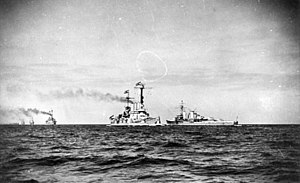Reichsmarine
This article needs additional citations for verification. (April 2012) |
| Reichsmarine (RM) | |
|---|---|
| Active | 1919–1938 |
| Country | |
| Type | Navy |
| Part of | Reichswehr |
| Insignia | |
| War Ensign (1933–1935) |  |
| War Ensign (1921–1933) |  |
| War Ensign (1919–1921) never used |  |
The Reichsmarine (German: [ˈʁaɪçs.maˌʁiːnə], Navy of the Realm) was the name of the German Navy during the Weimar Republic and first two years of Nazi Germany.[1] It was the naval branch of the Reichswehr, existing from 1919 to 1935. In 1935, it became known as the Kriegsmarine, a branch of the Wehrmacht; a change implemented by Adolf Hitler.
Vorläufige Reichsmarine
The Vorläufige Reichsmarine (Provisional Imperial Navy) was formed after the end of World War I from the Kaiserliche Marine.
The provisions of the Versailles Treaty restricted the German Navy to 15,000 men and no submarines, while the fleet was limited to six pre-dreadnought battleships, six cruisers, twelve destroyers, and twelve torpedo boats. Replacements for the outdated battleships were restricted to a maximum size of 10,000 tons.
Reichsmarine


Extent and equipment
The Treaty of Versailles limited the size and armament of the Reichsmarine and prevented it from introducing new technologies. The restrictions were intended to prevent the German Navy from becoming a threat to the Allied powers. On the other hand, the Allies had made certain that the Reichsmarine would be in the foreseeable future the strongest power in the Baltic Sea, in order to serve as a counterweight against the new Soviet Union, which was viewed with distrust by the Allies.
Germany was only allowed six battleships, six cruisers, twelve destroyers, and twelve torpedo boats. The Reichsmarine tried to meet the arms restrictions with secret armament and technical innovations such as the introduction of the pocket battleship.
List of Reichsmarine ships:
- Template:Sclass-s
- SMS Schleswig-Holstein (1908-1944)
- SMS Hannover (1907-1944)
- SMS Schlesien (1908-1945)
- Template:Sclass-s
- SMS Braunschweig (1904-1932)
- SMS Elsass (1904-1936)
- SMS Hessen (1905-1960)
- Template:Sclass-s
- SMS Berlin (1906-1929)
- Template:Sclass-s (3,033 tons, 10 × 1 - 105 mm (4.1 in) guns)
- SMS Nymphe (1900-1931)
- SMS Thetis (1901-1929)
- SMS Amazone (1901-1931)
- SMS Medusa (1901-1929)
- SMS Arcona (1903-1945)
- Emden-class cruiser (6,000 tons, 8 x 149 mm guns)
- Emden (1925-1945)
- Template:Sclass- cruisers (7,200 tons, 9 x 149 mm guns)
- Königsberg (1929-1940)
- Karlsruhe (1929-1940)
- Köln (1930-1945)
- Template:Sclass-s (8,000 tons, 9 x 149 mm guns)
- Template:Sclass-s (10,800 tons, 6 x 283 mm triple guns)
- Deutschland (1933-1948)
- Admiral Scheer (1934-1945)
- Admiral Graf Spee (1936-1939)
- Radio-controlled target ship
- SMS Zähringen (1902-1945)
References
- ^ Raymond C. Watson Jr. Radar Origins Worldwide: History of Its Evolution in 13 Nations Through World War II, Trafford Publishing, 2009, p. 229. Describes the meaning of Reichsmarine as "Realm Navy".
